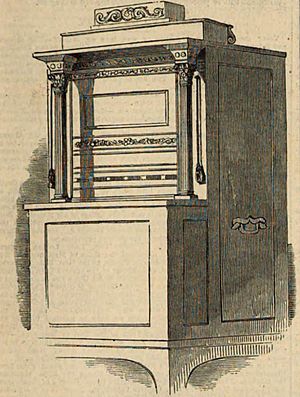The Eureka facts for kids
The Eureka machine, also known as the Latin Verse Machine, was a special device built in the mid-1800s. It could automatically create Latin poems! An inventor named John Clark from Bridgwater, England, made and showed off this amazing machine.
John Clark was born in 1785 in Greinton, Somerset. He moved to Bridgwater in 1809. There, he first worked as a grocer, selling food and household items. Later, he became a printer. In 1830, he began working on his Eureka machine.
By 1845, the Eureka was ready to be shown to the public. Clark displayed it in a famous place called the Egyptian Hall in London. People paid one shilling (an old type of money) to see it. The machine looked like a small bookcase with six narrow windows on the front. When it was making a new poem, it would play the British national anthem. After about a minute, the music would stop, and a new Latin verse would be complete.
Contents
How the Eureka Machine Worked
The Eureka machine was quite clever for its time. It used a special method to create Latin verses. This method wasn't entirely new; someone else had written about making Latin verses artificially in 1677. However, John Clark's big achievement was making the process fully automatic.
Making Latin Poems Automatically
The machine created poems called "hexameters." These were long, serious-sounding Latin verses. They followed a specific pattern, which allowed for many different combinations of words. All the verses it made were grammatically correct in Latin and usually made sense.
Here is an example of a verse the Eureka machine could create:
| Word 1 | Word 2 | Word 3 | Word 4 | Word 5 | Word 6 |
|---|---|---|---|---|---|
| MARTIA | CASTRA | FORIS | PRAENARRANT | PROELIA | MULTA |
This verse means something like: "Warlike camps outside foretell many battles."
Inside the Machine
The Eureka machine had six spinning drums hidden inside its cabinet. The words themselves weren't just printed on the drums. Instead, the words were encoded using rows of metal wires of different lengths.
Wooden sticks, called staves, would drop onto these wires. Each stave had letters printed on it vertically. When a stave fell, the wires would stop it at just the right spot. This made the correct letter appear in the window for each word. This clever system allowed the machine to pick and display the right words for each verse.
The Idea Behind the Machine
John Clark saw his machine as a way to show a theory he called "kaleidoscopic evolution." He believed the Latin verse was "thought up in the mind of the machine." Then, the machine would mechanically create and show the verse. Because of this, some people see Clark as an early thinker in the fields of cognitive science (how the mind works) and computational creativity (how computers can create things).
Where is the Eureka Machine Now?
John Clark passed away in 1853. After his death, the Eureka machine was passed down through his family. It went to his nephew, and then to his cousins, Cyrus and James Clark. In 1950, the machine was fixed after being neglected for some time. Today, the Eureka machine is kept in the Records Office at the Clarks' factory in Street, Somerset.
See also
- Generative_art#Literature


